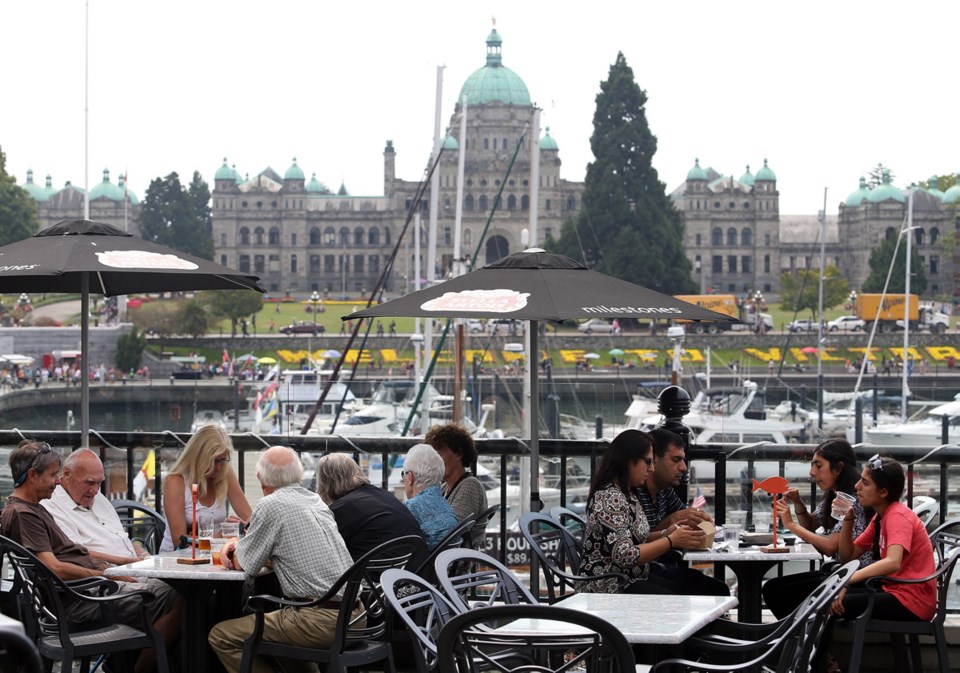New city regulations will bring increased opportunities for sidewalk cafes in Victoria — but it’s going to cost them.
Fees for sidewalk cafés will increase between 53 and 174 per cent under an updated bylaw and regulations which were given preliminary approval by councillors this week.
The new fee structure is expected to almost double the total revenue for the city, bringing in $103,859 from 126 accounts compared to the $56,714 currently collected.
The updated guidelines also set standards for access, lights, heaters and advertising. Cafés will be allowed use of adjacent parking stalls for “parklets,” provided traffic isn’t affected and where it doesn’t result in insufficient parking or loading areas.
The new fee formula, staff say, is market-based and more equitable. There are just two rates: $6.20 per square foot for businesses downtown and $3.80 for those outside downtown. Unlike the old bylaw, fees do not vary based on street orientation or whether or not there are fixed objects in place.
Some businesses will see more of an impact than others. Previously, cafes that faced north enjoyed a discount that has been eliminated. Under the new rates, cafes that face south will experience a 53 per cent increase in fees (an average of $319) while downtown cafes that are north facing will see a 150 per cent increase (an average of $524) because they lose the discount.
Ken Kelly, general manager of the Downtown Victoria Business Association, said any measure that enhances opportunities to open out onto the sidewalk “is fantastic.”
But, he said, the percentage increase in fees is a concern and council might be better off taking a phased approach.
“Something of this nature is very price-point sensitive. It’s one of those return on investment [situations]. We want to animate the streets. We know that philosophically the city wants that, but are they presenting some barriers in ultimately achieving it?” Kelly said.
Public consultation conducted over four weeks in February and March saw strong support for the new regulations, staff say.
Tom Moore, co-owner of Crust Bakery with Crystal Moore on Fort Street, said a fee increase “is going to hurt the wallet a bit.”
“It’s very difficult for a small business to pass that cost increase on to their customers. So a lot of the time we end up having to swallow that price increase,” he said.
Crust has benefited from a pilot parklet developed right outside their doors through the Fabulous Fort business association. The bakery didn’t have to pay for it, but it’s been a successful addition to the street, Moore said. “People want to eat outside when they’re on their lunch break, especially the downtown office lunch crowd. They want to get some fresh air. They want to sit outside and see the action and people watch. It’s in human nature.”
Still, Moore noted, the parklet isn’t for the exclusive use of Crust patrons.
Mayor Lisa Helps said large percentage fee increases reflect a “problem with how we’ve done business in the past.
“Any normal business reviews their fees that they charge their clients on a regular basis and we haven’t looked at the fees since 2002. So that’s a problem.
No thought was given to phasing in the increase because it wasn’t an issue during the public consultation process.
“If we had heard loud and clear from the public consultation that that was an impediment to people setting up patios then we would have reacted to it. But the feedback was: great that you’re making it easier. Great that there’s not all these different things if you’re facing the sun or facing the shade and let’s get on with getting more patios out there,” Helps said.
She said regular fee reviews are planned “so that they are reasonable; they are market driven when it’s using public space and that we update them on a regular basis so we don’t have a 14 year gap.” Helps said the bylaw update is designed to “increase the vibrancy of public spaces.



